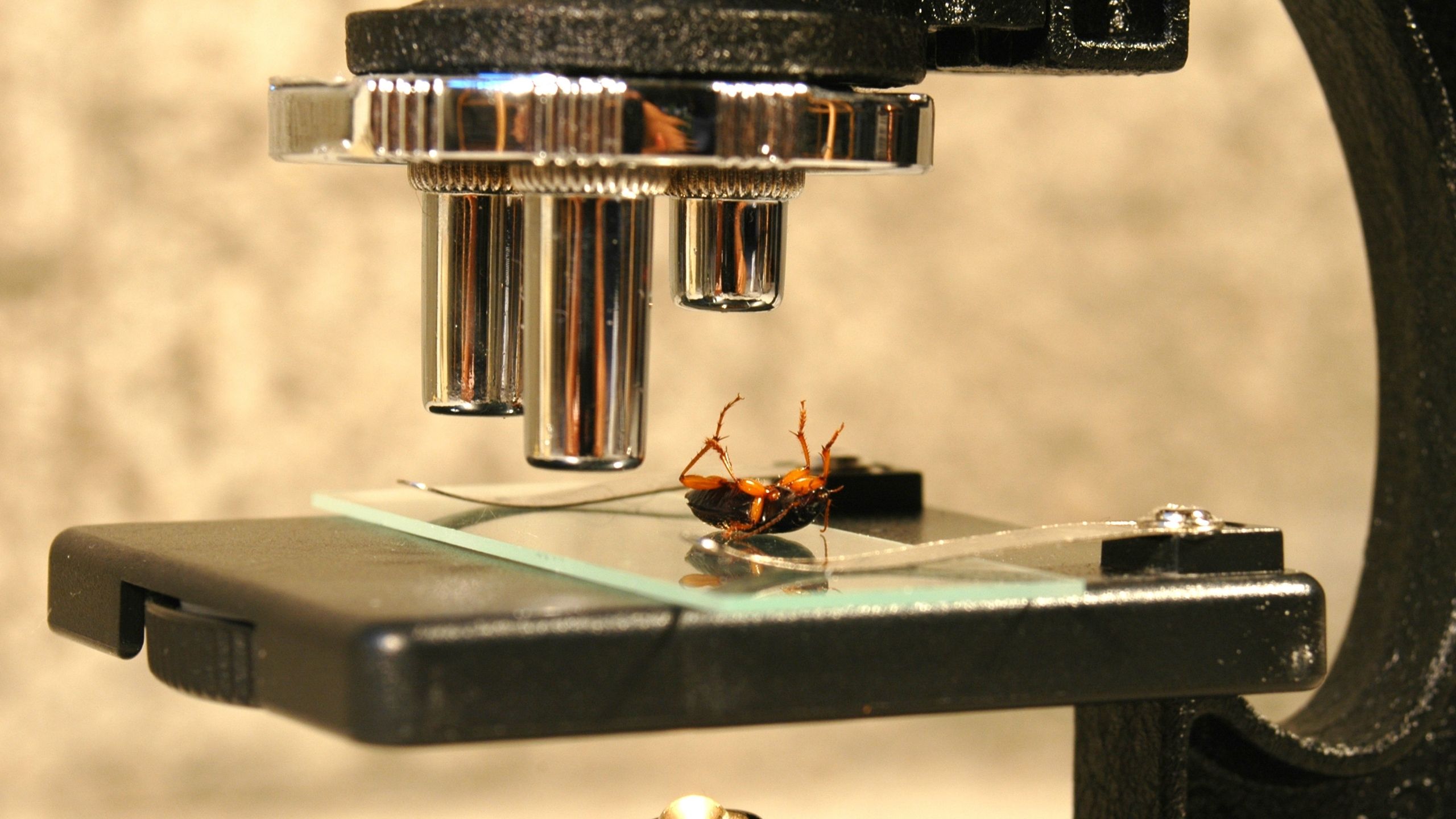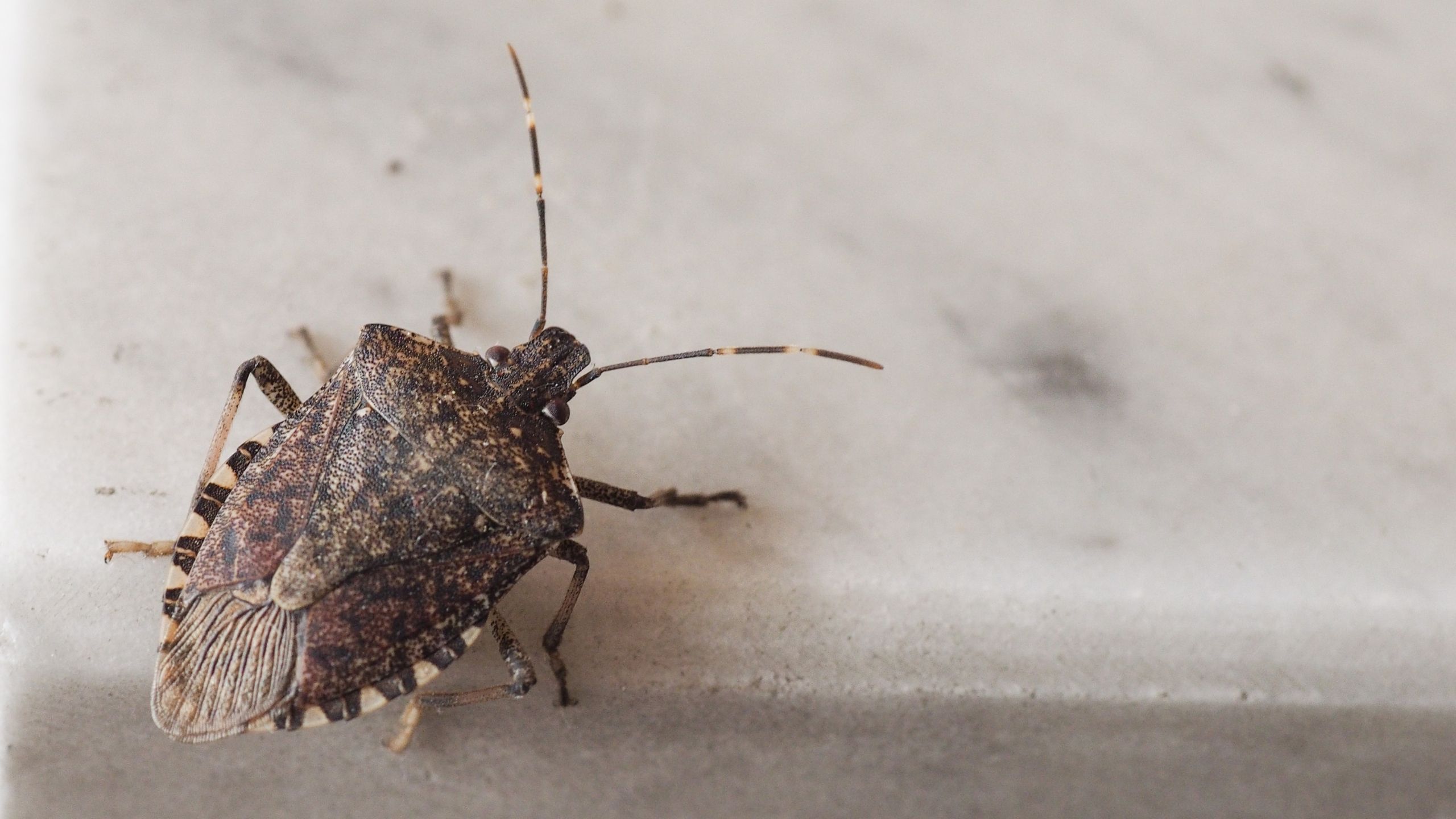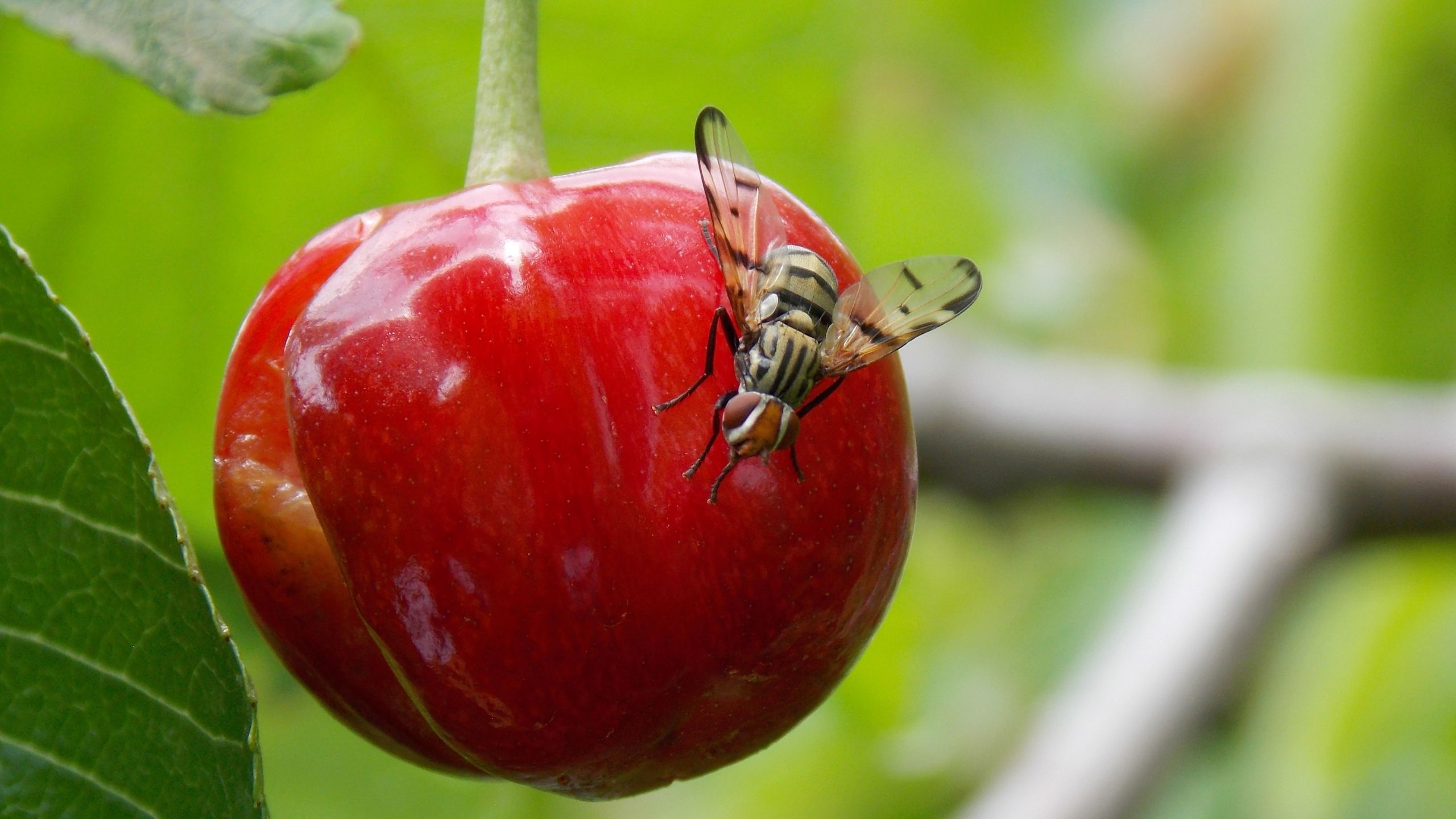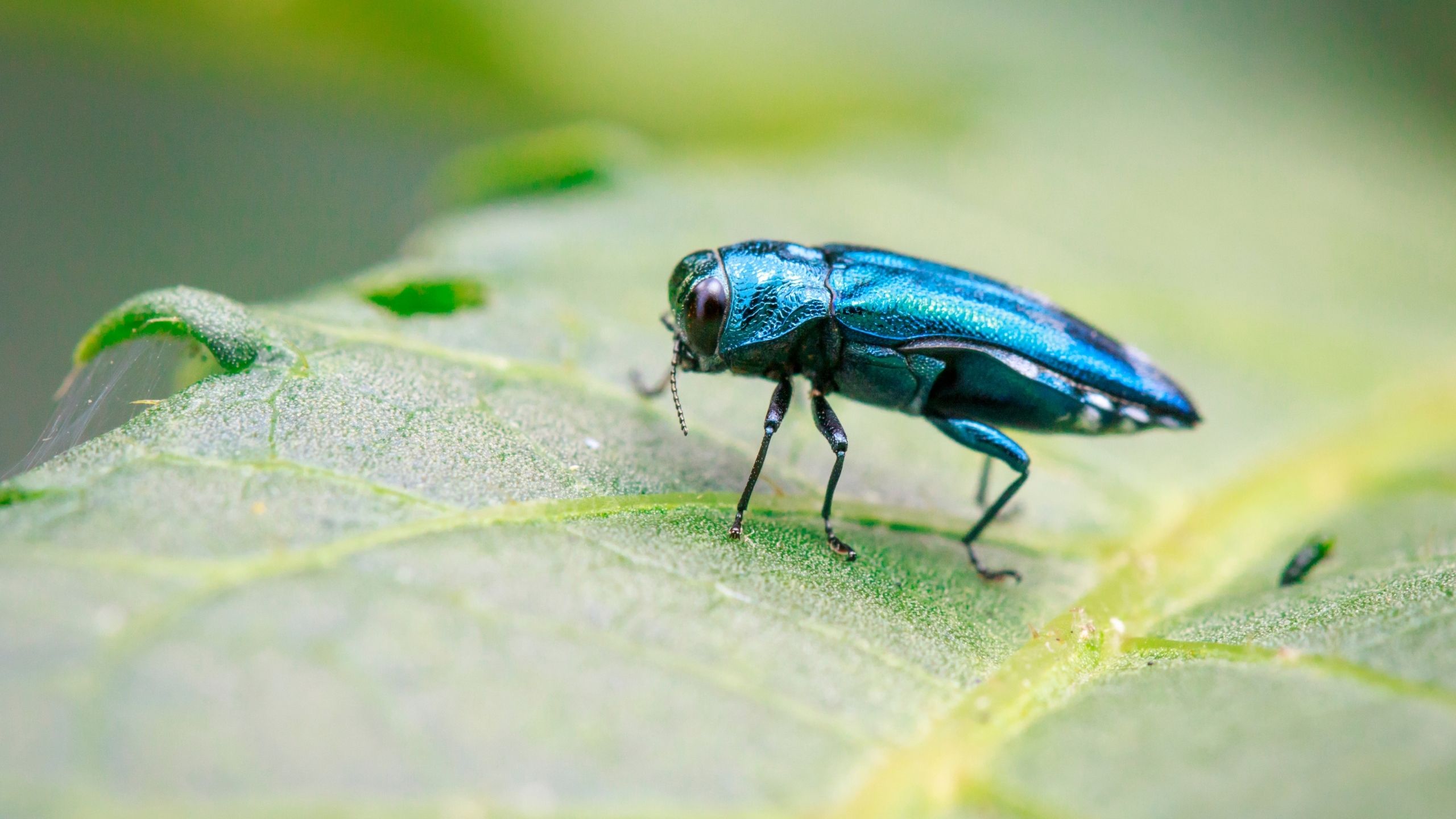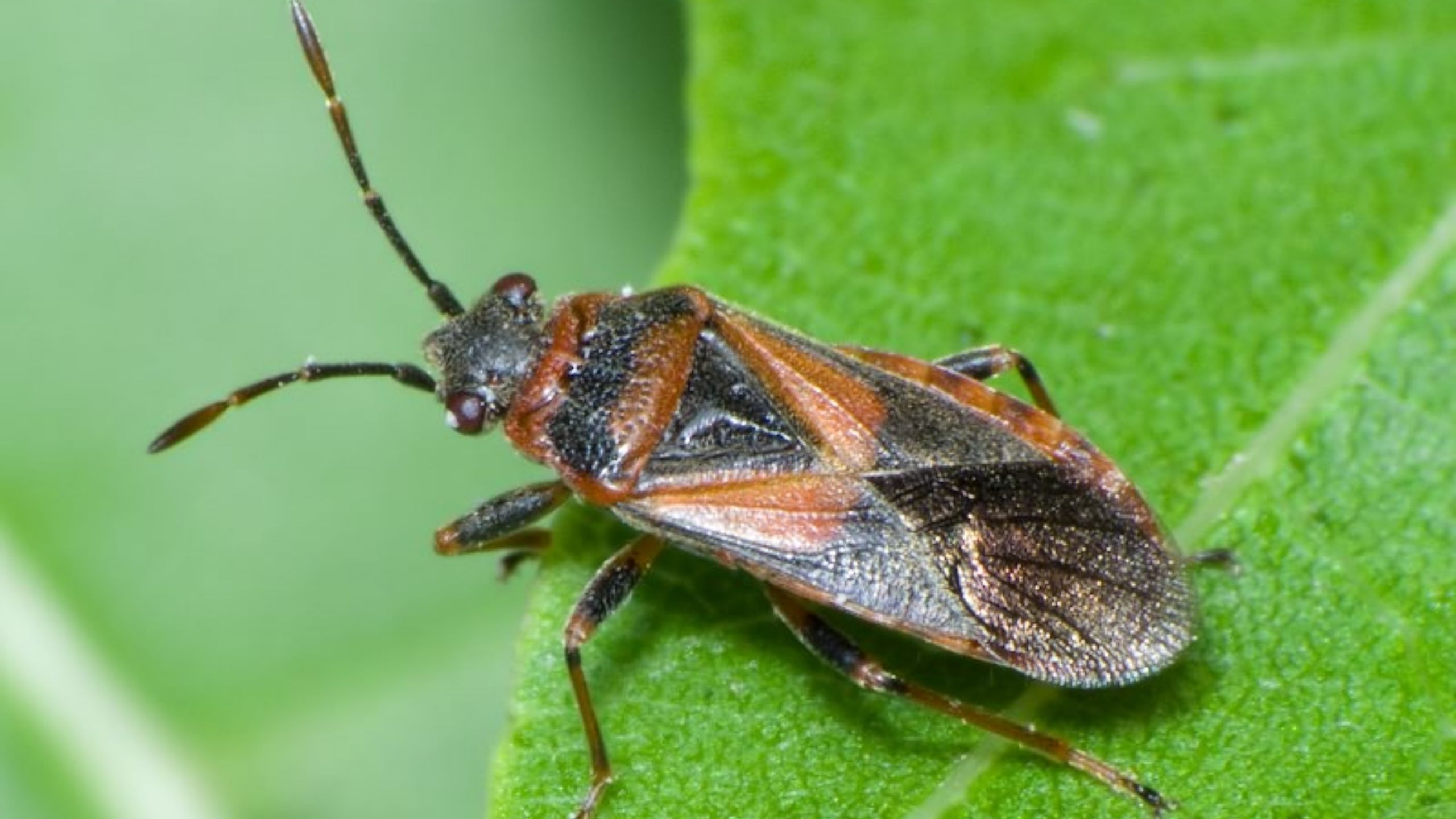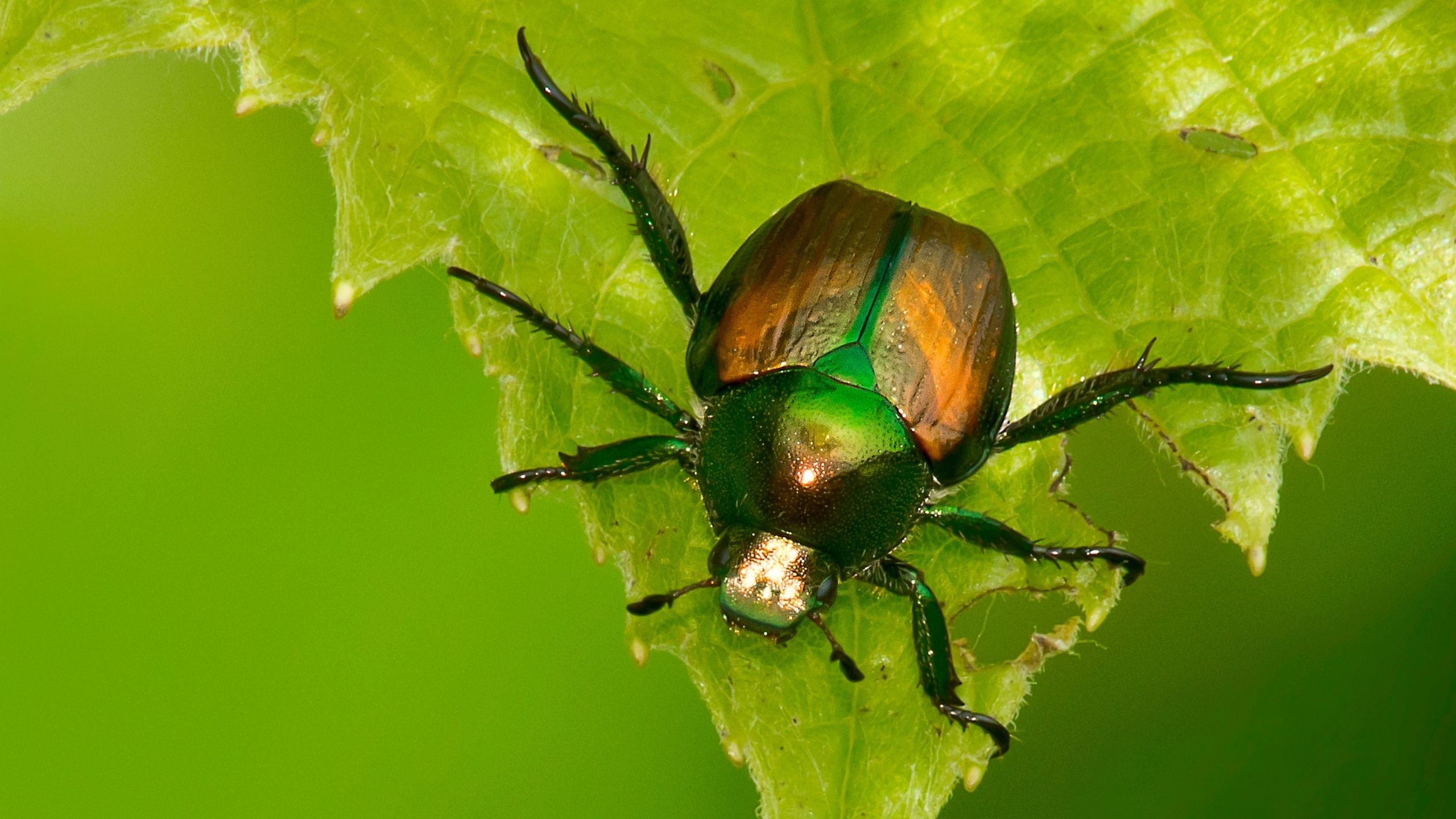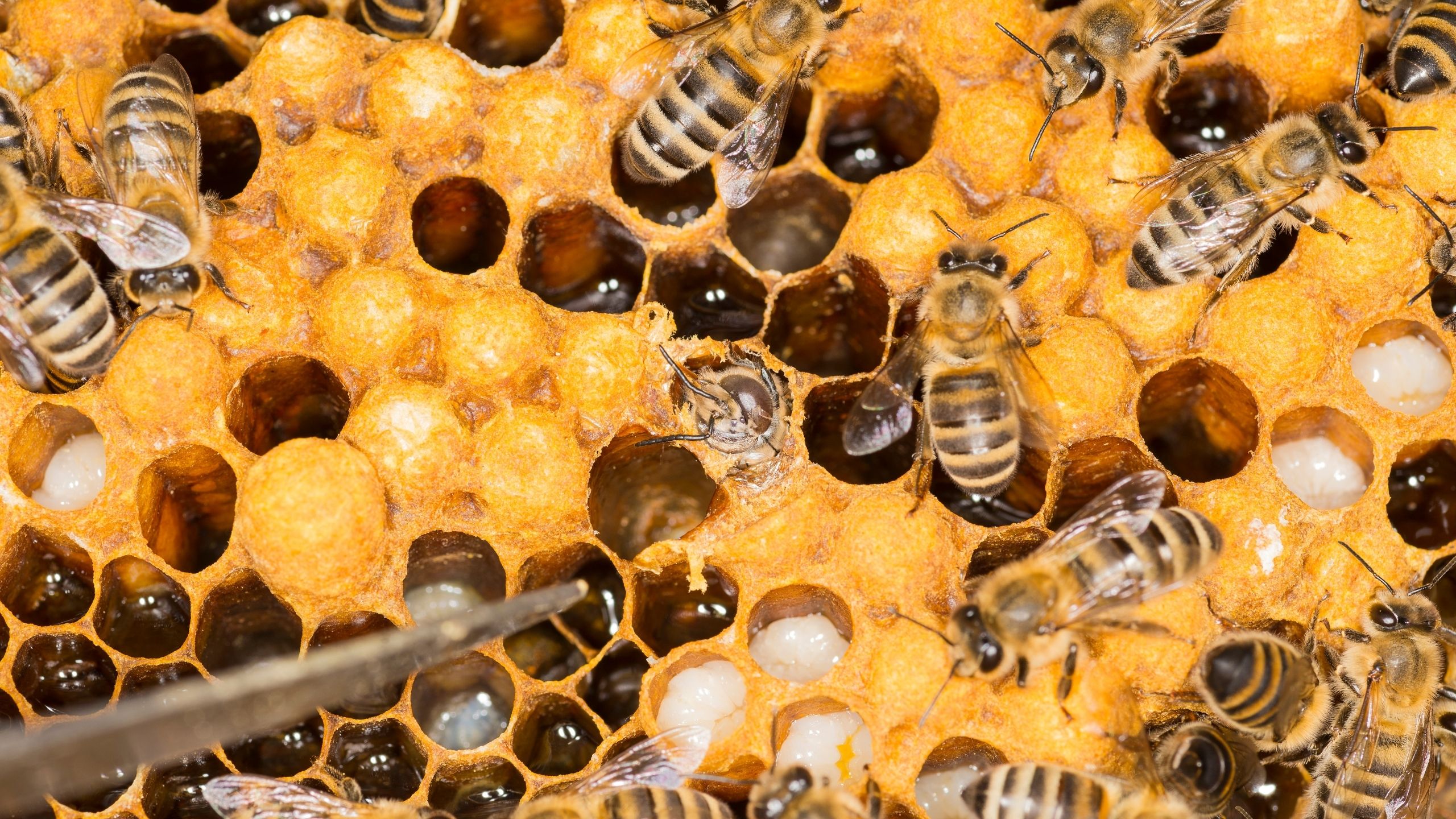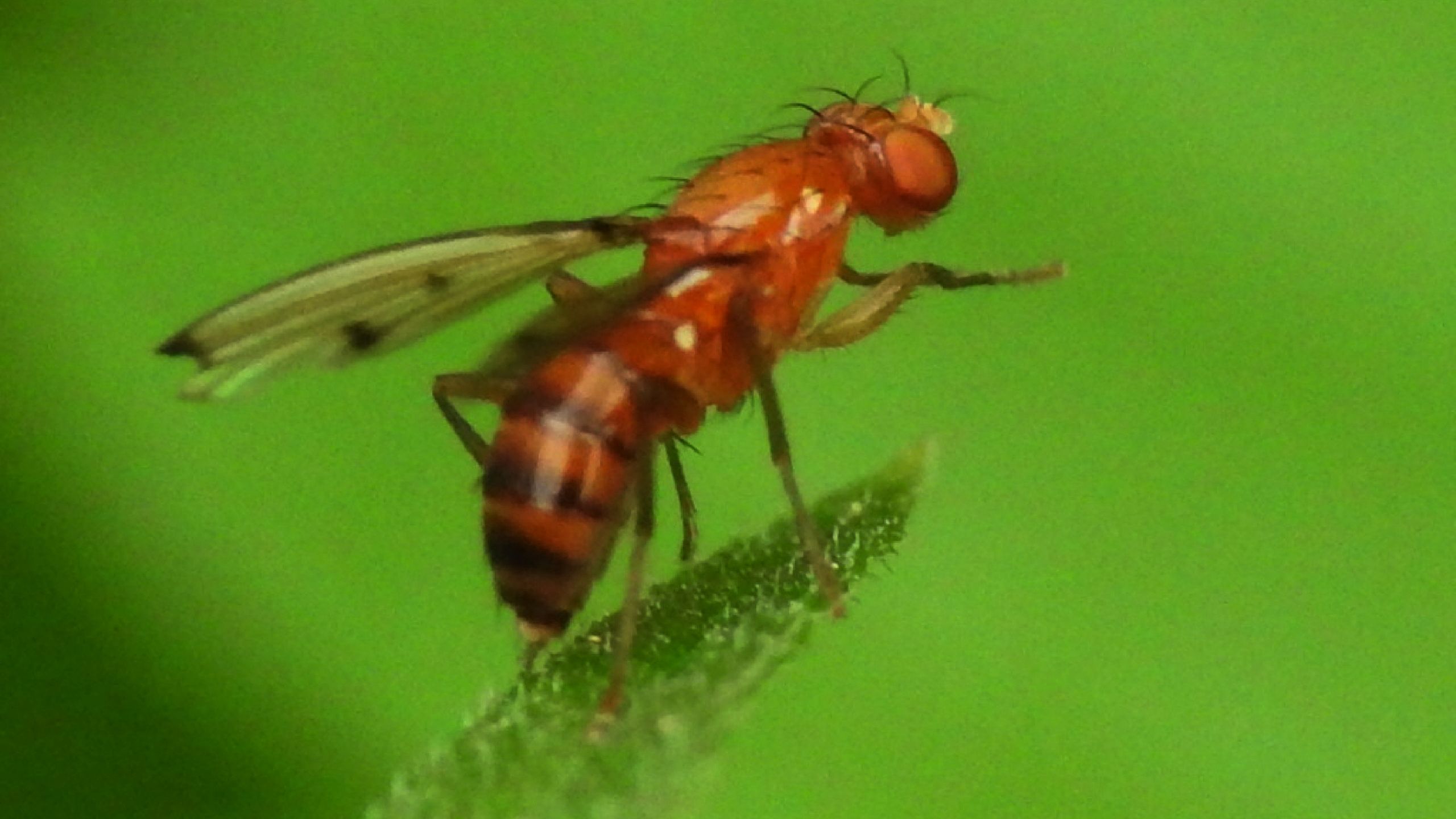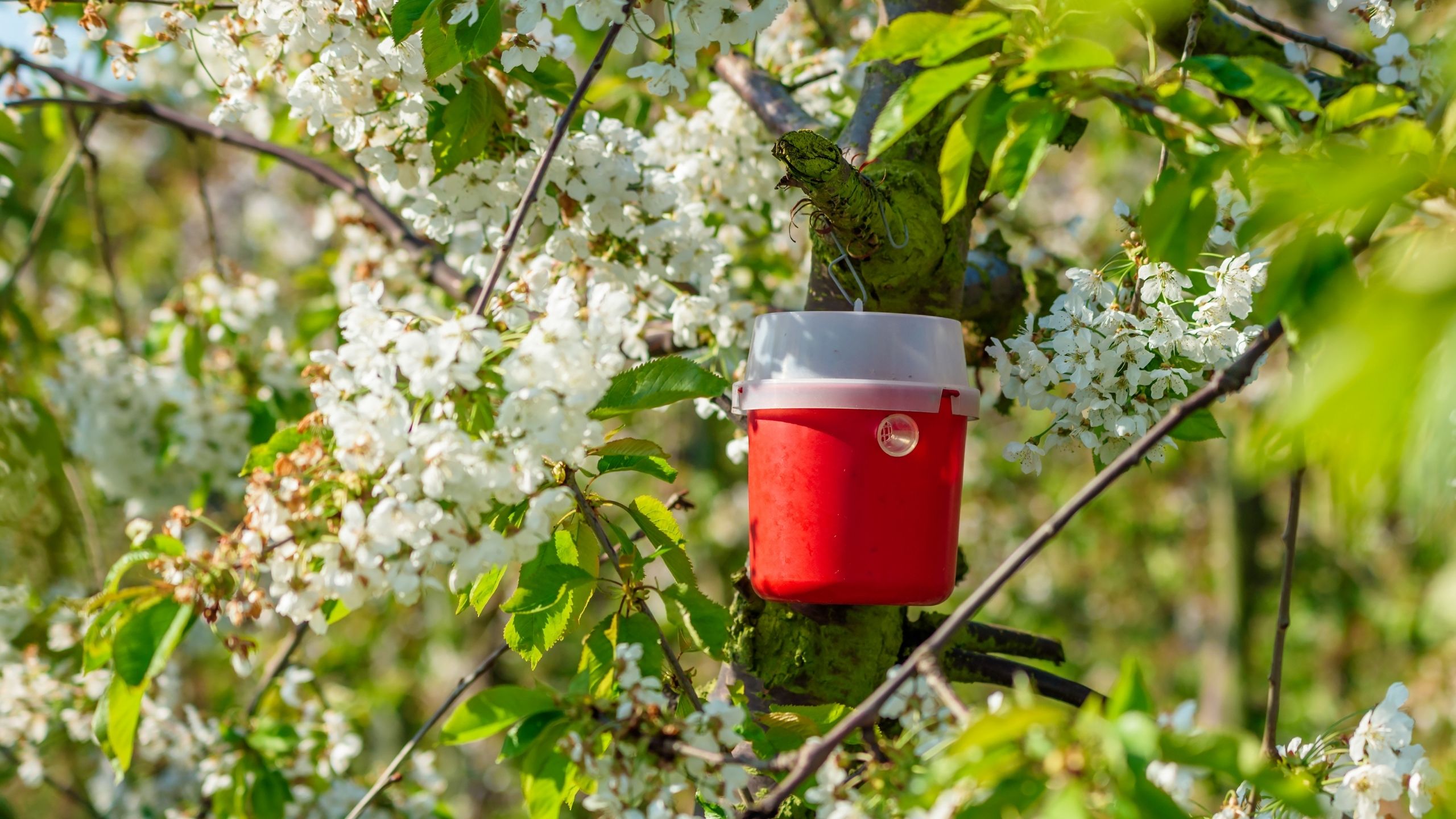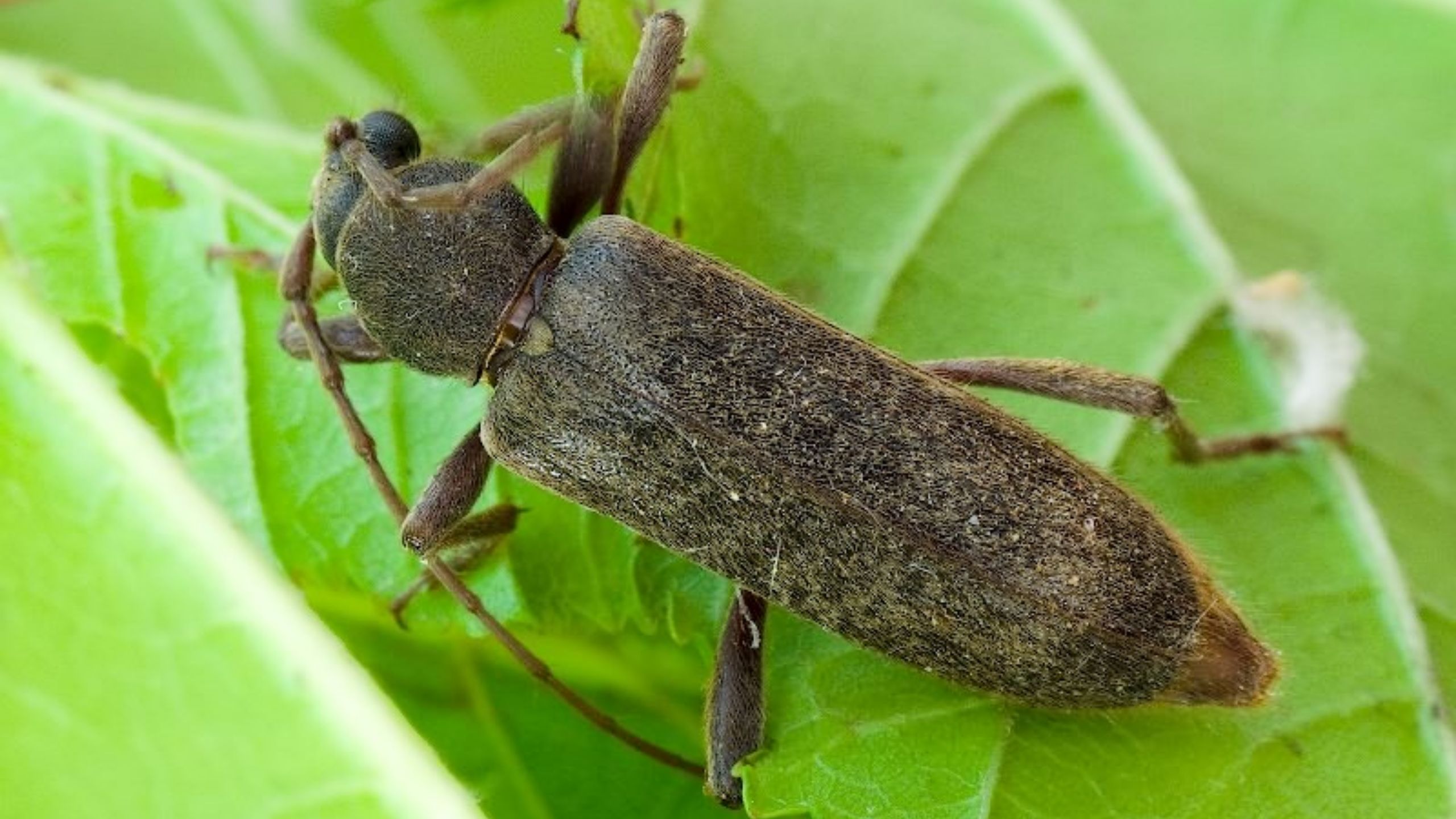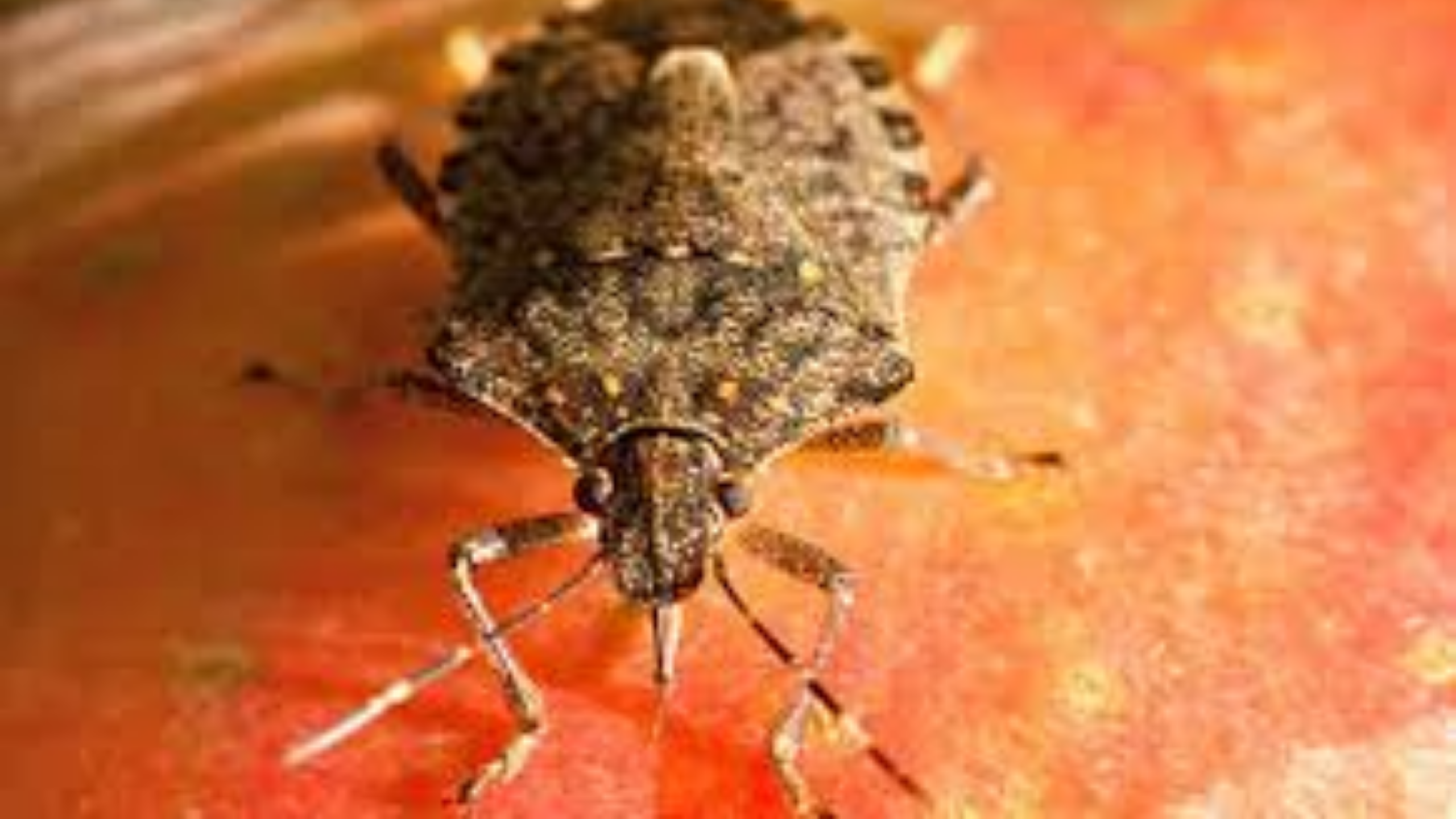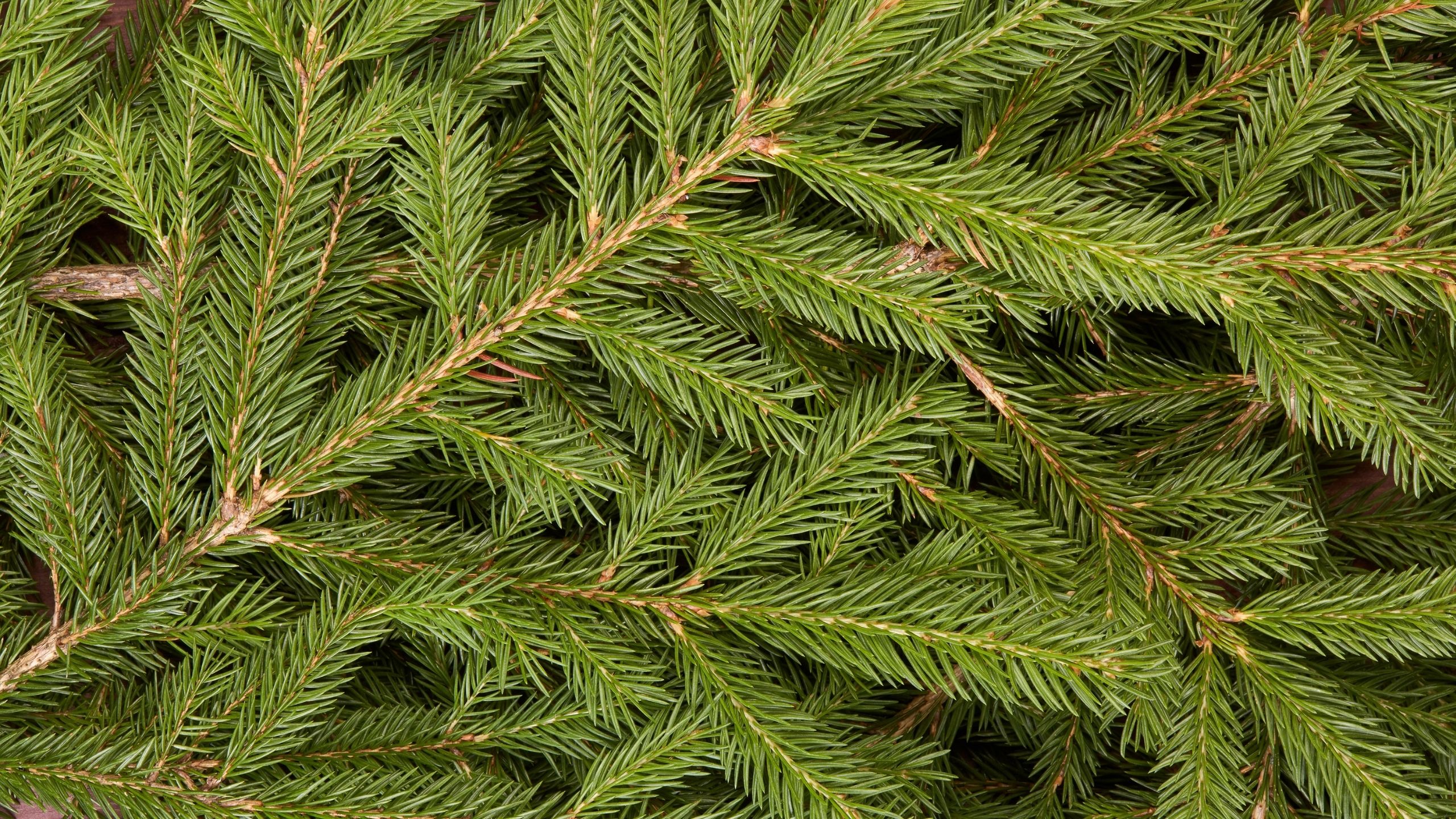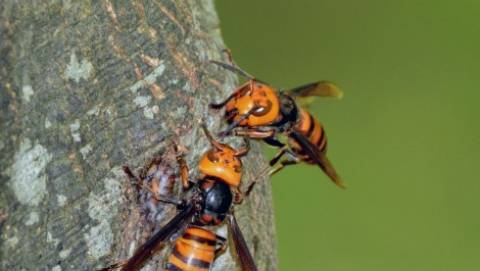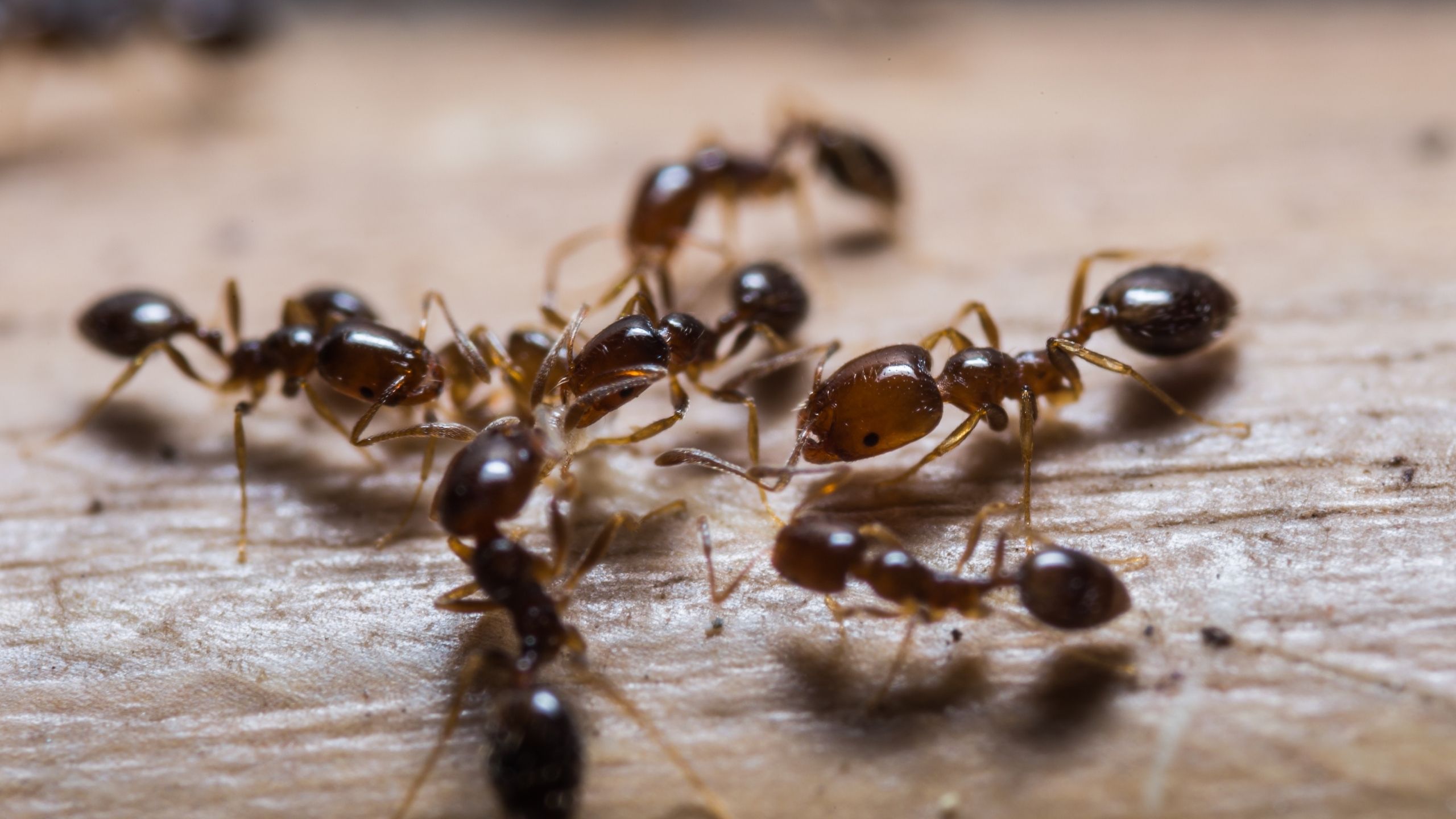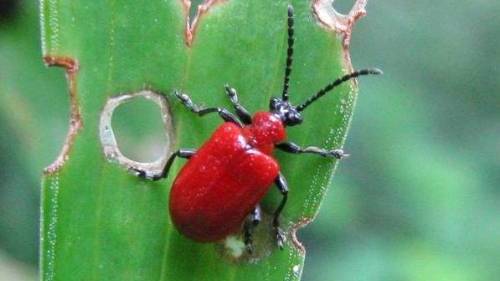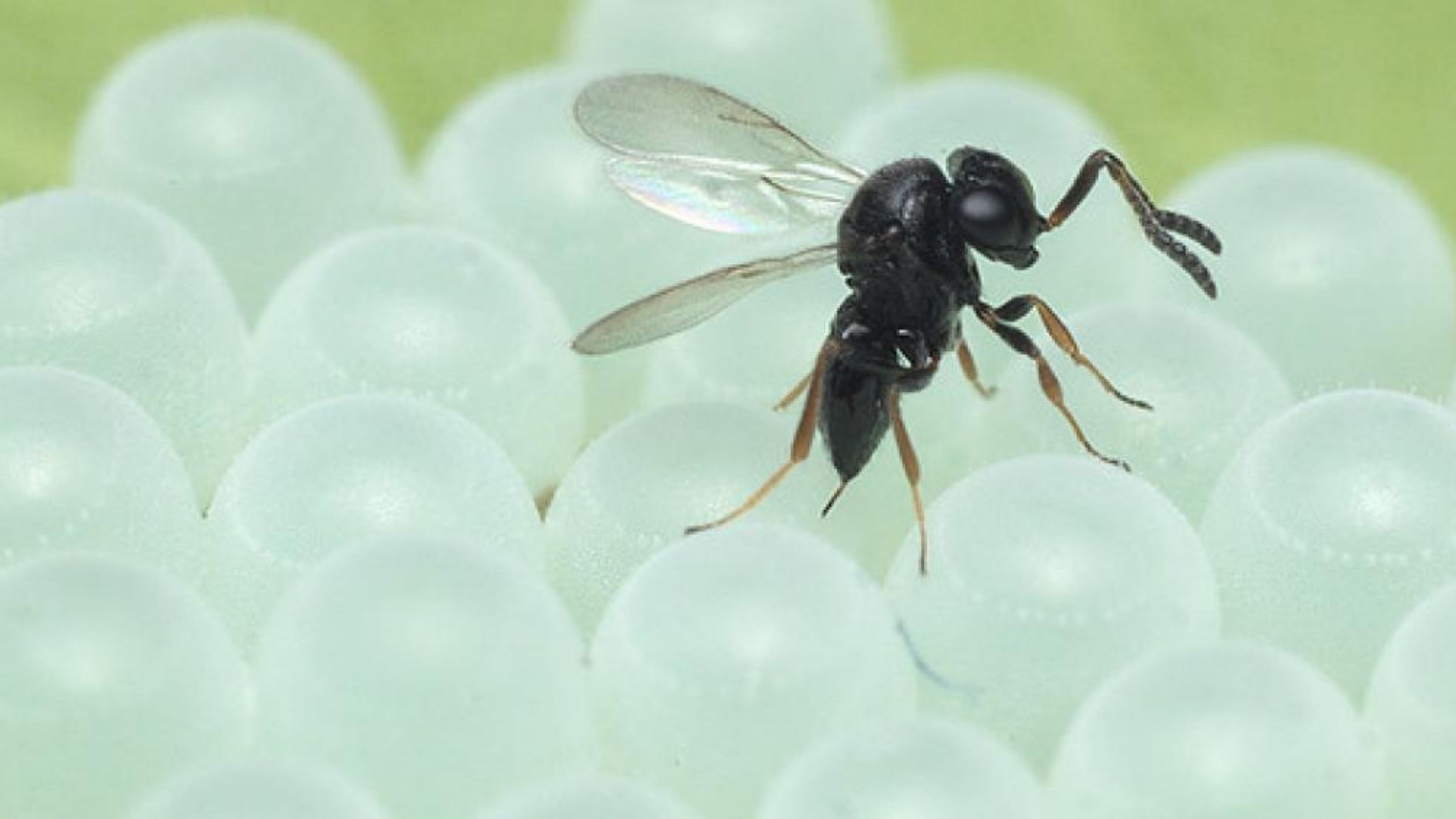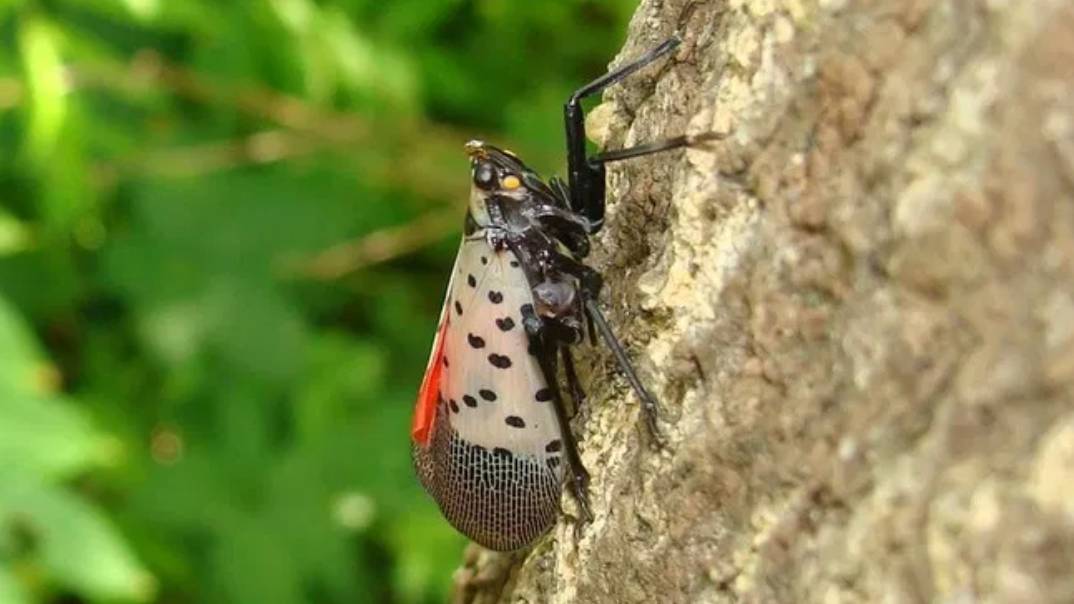Spotted Wing Drosophila
[Drosophila suzukii (Matsumura)]
September 2017
Lori Spears, Extension Entomologist (No longer at USU) • Cami Cannon, Veg IPM Associate • Diane Alston, Extension Entomologist (No longer at USU) • Ryan Davis, Arthropod Diagnostician (No longer at USU) • Cory Stanley-Stahr, Extension Entomologist (No longer at USU) • Ricardo Ramirez, Extension Entomologist (No longer at USU)
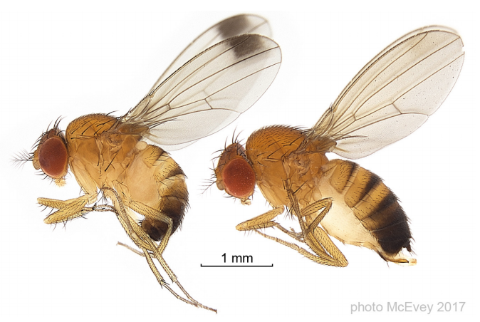
Image courtesy of Shane F. McEvey, Australian Museum, via
Wikimedia Commons.
Quick Facts
- Spotted wing drosophila (SWD) is an invasive insect that is native to Southeast Asia; it was first detected in the continental U.S. in 2008 and in Utah in 2010.
- SWD is a small vinegar fly that infests ripening, ripe, and overripe fruits. Preferred hosts include stone fruits, berries, and soft-skinned vegetables.
- Monitoring SWD with effective traps and baits is imperative to avoid harvesting and marketing infested fruit.
- SWD management tactics include removing nearby alternative host plants, timely harvest of fruit, expanding the preventive insecticide program to pre- and post-ripe fruit stages, and orchard sanitation.
Spotted wing drosophila (SWD), Drosophila suzukii (Matsumura) (Diptera: Drosophilidae) (Fig 1), is an invasive vinegar fly native to Japan and parts of Thailand, India, China, Korea, Myanmar, and Russia. It infests soft fruits and vegetables, and differs from other species in the genus by laying eggs in healthy, developing fruit, and over-ripe or damaged fruit. Because adult females will lay eggs in maturing fruit, larvae can be unknowingly present in fruit that is harvested for market (Fig 2).
SWD is named for a dark spot on each wing of the male fly. Many flies have spots on their wings. Small flies with only one spot per wing should be considered suspect. Any suspect SWD should be sent to the Utah Plant Pest Diagnostic Lab at Utah State University for identification.
In the U.S., SWD has been established in Hawaii since the early 1980s, was first recorded from California in 2008, and has subsequently spread to nearly every state, including Oregon (since 2009), Washington (2009), Utah (2010), and Idaho (2012). SWD is now a severe economic pest of fruit in many parts of the U.S. Because SWD is widely distributed throughout the U.S., it is not considered a quarantine pest.
In Utah, SWD adults have been caught in traps in apple, cherry, peach, plum, and caneberries in commercial orchards and home gardens. SWD flies have also been caught in traps in wild habitats, especially riparian areas, with river hawthorn, serviceberry, wild rose, Russian olive, elderberry, golden currant, dogwood, and other wild and feral fruits. Since its first detection in Utah, SWD has not been found to cause economic injury in any fruit or vegetable crop. Researchers suspect that the cold winters and hot summers in northern Utah delay primary development of SWD until late summer to early fall when temperature conditions are more ideal for this pest. At this time, late-season maturing, soft fruits are at greatest risk for SWD infestation.
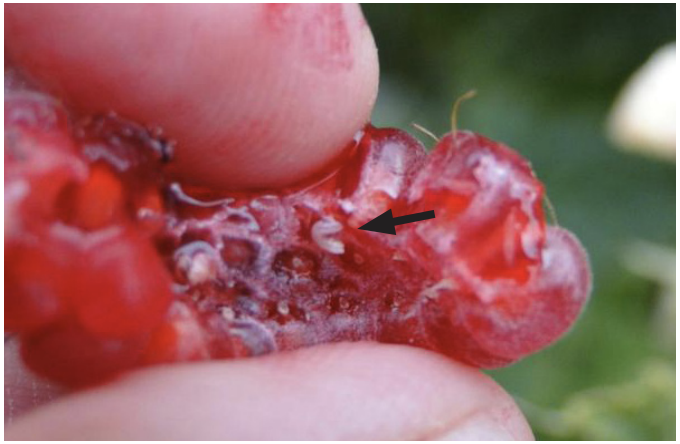
of Hannah Burrack, North Carolina State University, Bugwood. org.
Identification
Adult: Reproductive, Dispersal, Damaging, and Overwintering Stage
- About 1/12-1/7 in (2-3.5 mm) long (Figs 1,3,4)
- Pale brown body with unbroken lateral bands on the upper abdomen (last body segment)
- Red eyes and short, feather-like antennae
- Males have a single black spot on the leading edge of each wing (near the tip) and two dark bands (“sex combs”) on each lower foreleg (Fig 3)
- Females can be distinguished from other drosophilids by a large, saw-like ovipositor (egg-laying device) located on the end of the abdomen (Fig 4)
Egg
- Less than 1/32 in (0.6 mm) long (Fig 5)
- White to creamy translucent in color; cylindrical in shape
- Two thin respiratory filaments occur on one end. Filaments may protrude from fruits with eggs present
Larva: Damaging Stage
- About 1/16-1/6 in (1.5-4 mm) long (Figs 2,5)
- Cream-colored maggots with black mouthparts
- Mature larvae can be distinguished from other fruit fly larvae (e.g., cherry fruit fly) by having a smaller body that is tapered at both ends, and shallow fruit feeding
Pupa: Possible Overwintering Stage
- About 1/10 in (2-3 mm) long (Fig 5)
- Brown and cylindrical with two extensions on one end

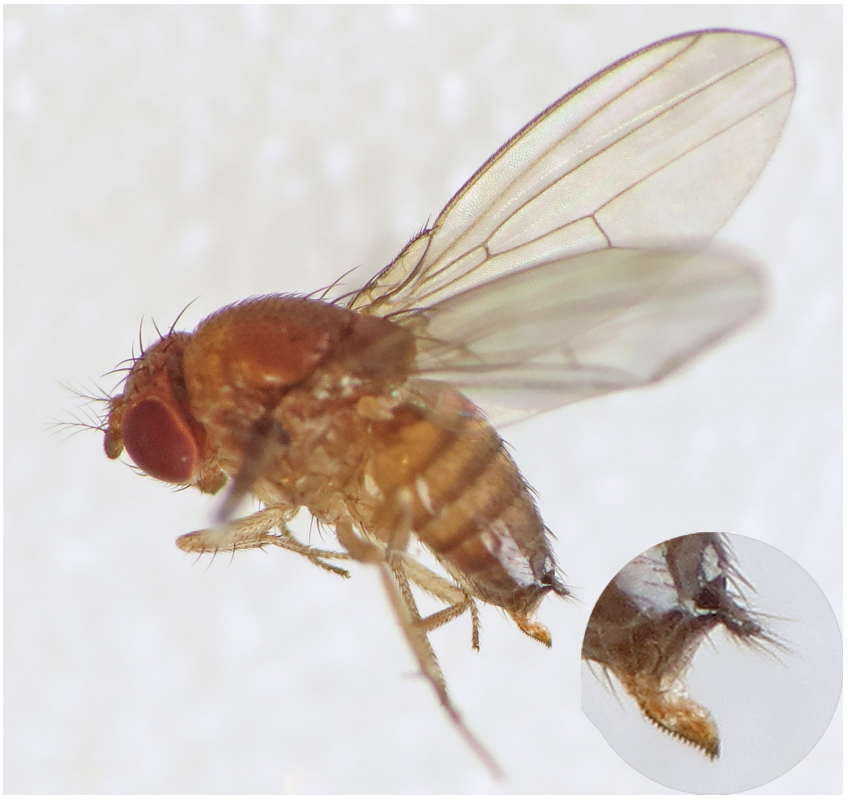
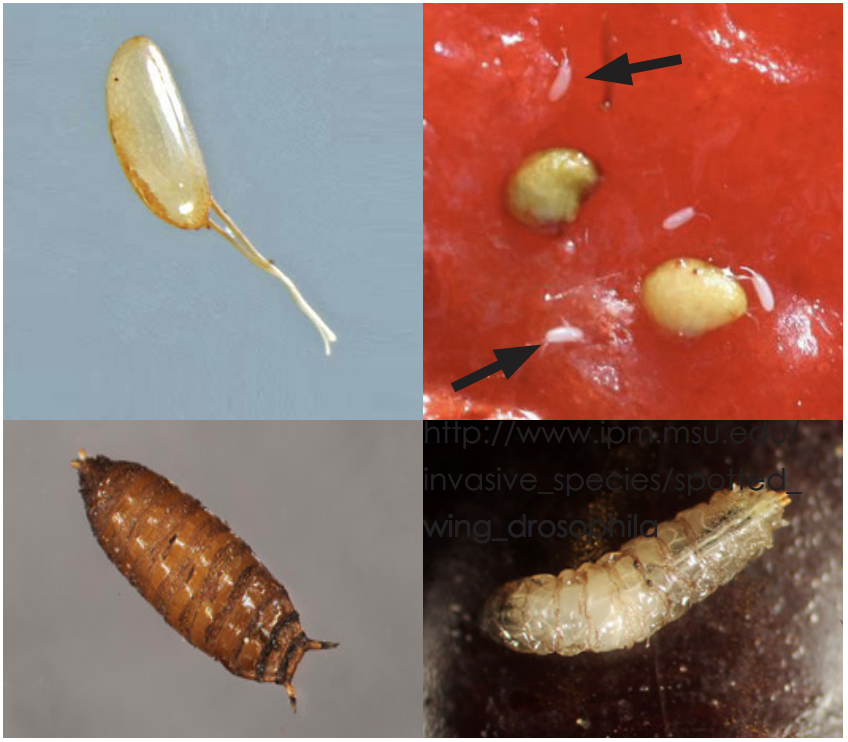
Life History
Adults and pupae are common overwintering life stages; however, adults are the only life stage that has been detected in Utah to-date. Because adults have been detected in the same locations in subsequent years, this suggests that SWD is overwintering, reproducing, and completing full generations in Utah. In Utah, trap captures of adults peak from late September to early November.
Adult flies increase activity in the spring as temperatures warm (Fig 6). They are most active between 68°F to 77°F (20°C-25°C), and prefer hours of dawn and dusk. Degree-day (DD) models estimate that adult emergence begins at 270 DD (lower development threshold 50°F) (late April to early May) in northern Utah; however, low populations are difficult to detect and few adults have been detected in traps before August. The adult lifespan can vary from 8 days to 9 weeks depending on environmental conditions and time of year.
Egg-laying begins in the spring when average temperatures exceed 50°F (10°C), and continues through the growing season until average temperatures decline below 42°F (5.5°C) in the autumn. Females typically lay 1-3 eggs per fruit and 7-16 eggs per day. A female may lay over 350 eggs in her lifetime. Eggs typically hatch in 12-72 hours.
Larvae feed inside the fruit for 3-12 days before pupating. Larvae can pupate within or on the outside of fruit, or they may drop to the soil. Pupae are usually found in fruit or in the leaf litter or soil below infested fruit. Pupation requires 3-15 days.
When average minimum temperatures in the fall drop to 41°F (5°C), SWD adults seek protected sites for the winter, such as under leaf litter and rocks. Degree-day models estimate that SWD may complete 3-16 generations per year in Utah. Based on few detections of adults in traps before August, it is speculated that SWD completes only a few generations per year in northern Utah.
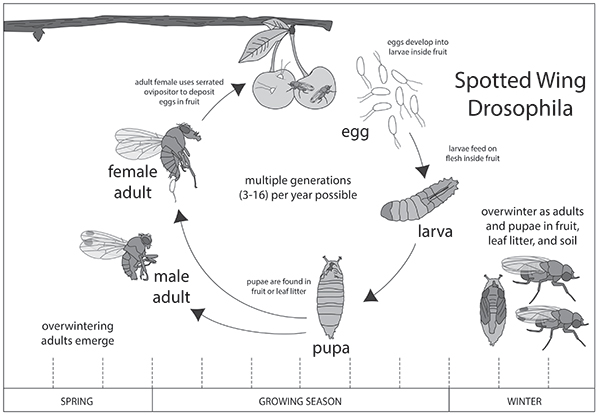
Plant Hosts
SWD hosts include tree fruits, berries, some soft-skinned vegetable fruits, and many ornamental and wild fruits (Table 1). Soft-skinned fruits (e.g., cherry, peach, raspberry, and blackberry) are most vulnerable to attack by SWD as they near maturity; firmer-skinned fruits (e.g., apple, tomato, and grape) become more attractive to SWD when they are over-ripe or damaged. SWD is a late season pest in Utah, so fruits that are harvested early in the season are less susceptible to SWD infestations.
Table 1 Plant hosts of SWD.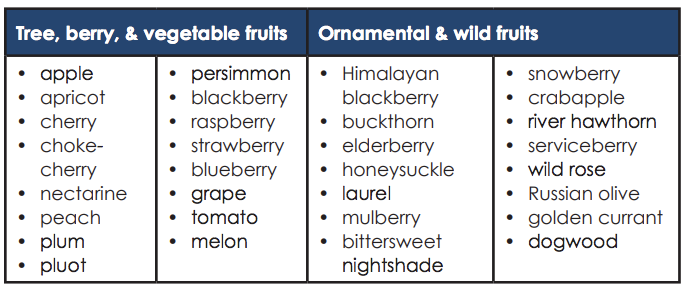
Injury Symptoms
Adult females cause injury to fruit via egg-laying. Egglaying scars are pin-prick holes in the fruit skin (Fig 7). The area of oviposition or pin-pricks may become sunken and when closely examined, eggs within fruit may have two hair-like filaments protruding through the fruit skin.
Primary damage is caused by larval feeding and tunneling in the fruit flesh. After 5-7 days of larval feeding, the fruit skin begins to show damage symptoms. Larval feeding will cause the fruit to become soft, wrinkled, and spotted (Fig 8). As larvae increase in size, they cut breathing holes through the fruit skin. Fruit that has been infested may exude a sappy juice when squeezed.
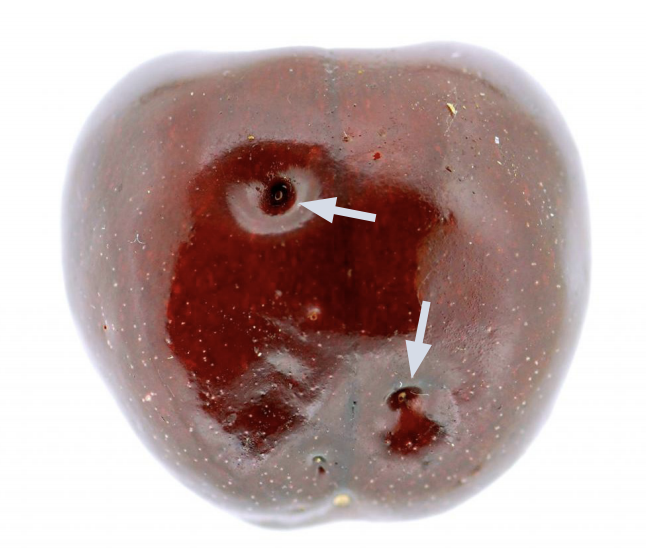
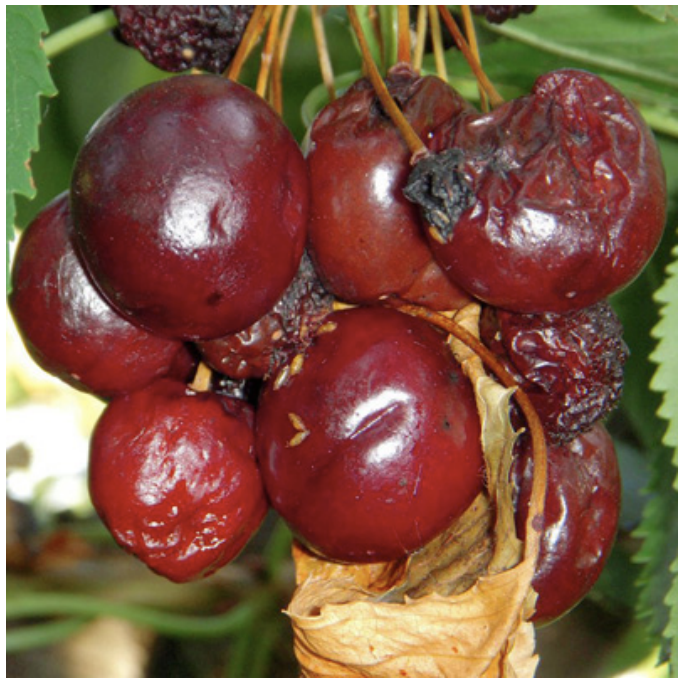
Monitoring
Adult flies can be monitored using bait traps, and larval infestations of fruit can be determined by visually inspecting fruit. Control is not recommended unless SWD is caught in monitoring traps or fruit infestation is detected. Begin monitoring before the earliest fruit begins to ripen.
Traps
Commercial monitoring traps are available for purchase (see Sources of Monitoring Supplies), but simple traps can be made from a 16 to 32 oz clear plastic cup and lid (Fig 9). Drill, punch, or melt holes into the sides of the cup or the cup lid that are big enough for SWD to enter, but small enough (1/4 in or 3/16 in drill bit size) to exclude larger insects. Leave a portion of the circumference around the cup without holes to allow for easy pouring of the liquid trap bait and trapped insects when replacing the bait. Use a string or wire hanger threaded through holes punched in the cup sides to hang the trap at fruit level in a tree or from a stake. Traps perform best when placed in cool and shady areas of the field or orchard.
Dry traps constructed from yellow sticky cards baited with a lure are another option; however, experiences in Utah have found that these cards attracted a large number of non-target flies that hampered identification of SWD.
For commercial plantings of a single crop type of 10 acres or greater, use at least one trap per 5 acres (minimum of two traps). For smaller commercial plantings of < ½ acre, use one to two traps per crop type (e.g., raspberry, cherry, and tomato). For residential garden sites, use one to two traps per site.
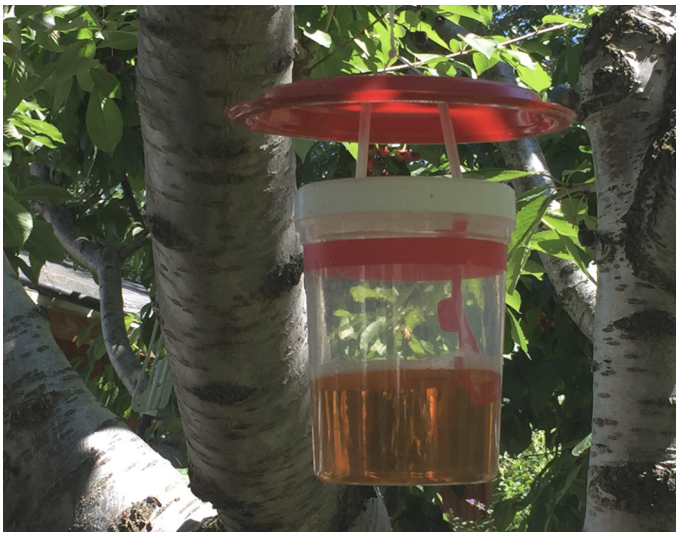
Note that there are holes (not shown) drilled into the cup lid for fly entry.
Trap Bait
The most common liquid baits used in SWD traps are apple cider vinegar (ACV) or sugar-water-yeast mixtures (2 tsp active dry baker’s yeast, 4 tsp white sugar, 12 oz (1½ C) warm water—good for two to three traps). Both baits are effective; their preference has varied among studies and locations. Consult the Invasive Fruit Pest Guide for Utah for a discussion on the advantages and disadvantages of ACV and yeast baits.
Adding 1 to 2 drops of unscented dish soap to liquid bait mixtures will break the surface tension and improve the trapping efficiency of the bait. Liquid baits should be replaced at least weekly. Continue to monitor and check traps through harvest of susceptible fruits.
Adding a synthetic, commercially available dry lure with your chosen trap and trap bait may provide an early warning in susceptible crops (see Sources of Monitoring Supplies) and increase SWD captures. Commercial lures last 1-2 months in the field (1 month in hot climates).
Checking Traps
Check traps weekly and keep records of SWD activity in each trap at each weekly check. In the field, carefully decant the liquid bait and captured flies from the trap into a storage container. Refill the trap with fresh bait solution. Do not combine new with old bait, or dump old bait on the ground near monitoring sites.
Transport the trap bait containers indoors and then pour the bait solution through a fine mesh strainer and wash the insect specimens by carefully “dipping” the strainer into another water-filled container (Fig 10). Use a hand lens or magnifying glass to examine the floating insects. If you need a closer look at a fly, use forceps to remove it and place it in a different dish. If identification help is needed, samples can be sent to the Utah Plant Pest Diagnostic Lab at Utah State University. For greater details about processing the liquid bait to find SWD adults, consult the USU Extension fact sheet on Monitoring for Spotted Wing Drosophila in Utah.
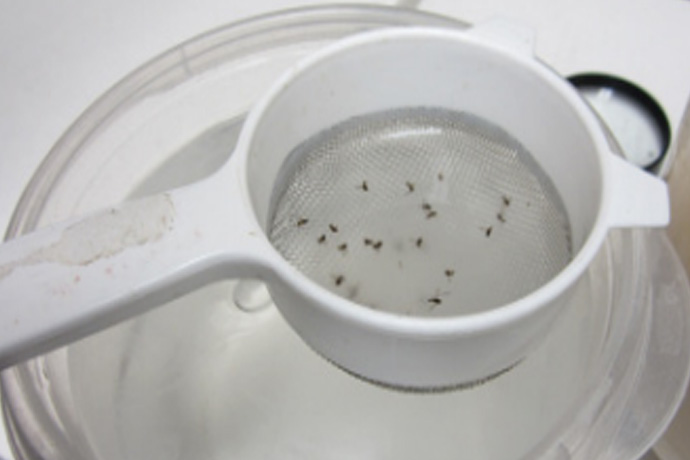
Image courtesy of Cory Stanley-Stahr, EAG Laboratories/Wildlife International (formerly Utah State University Extension).
Fruit Monitoring
Visual inspection of ripening fruit for signs of SWD can be effective to detect infestations before they become severe. In addition, sugar or salt solutions can be used to float larvae from crushed fruit. Methods for monitoring fruit include using an extraction solution, pan extraction, bag extraction, and boiling fruit. For detailed information about these methods, consult the Invasive Fruit Pest Guide for Utah.
Non-Chemical Control
Non-chemical control methods are reliant on effective SWD monitoring. Non-chemical control methods can be used by homeowner and commercial fruit growers, but are generally more feasible for use on a smaller scale.
Sanitize: Maintain a clean orchard by eliminating fallen and infested fruit remaining on trees or plants after harvest. Dispose of infested fruit in a strong plastic sealable bag in the trash, or solarize the fruit under clear plastic in the sunshine. Composting or burying fruit is not effective in killing SWD.
Netting: Fine netting placed over branches as a sleeve or draped over the whole plant of small fruit trees or bushes may keep SWD adults from attacking fruit. Netting should be applied after flowering to allow for pollination, but before fruit begins to ripen and SWD activity is detected in traps. Mesh size should be 0.98 mm or smaller.
Early and Timely Harvest: SWD are attracted to ripe, ripening, and over-ripe fruit; thus, early and timely harvest reduces the exposure of susceptible fruits to SWD. Harvest fruit as early as possible and continue to pick fruit as it ripens. Select early maturing cultivars to avoid exposure to late-season SWD when populations tend to increase.
Chilling: After harvest, chill fruit immediately to 34°F to 38°F (1°C to 3°C), or to just above the fruit freezing point, for at least 12 hours and up to 3 days. This will stop development and kill many of the eggs and older larvae.
Open Crop Canopies and Manage Irrigation: SWD prefer humid shady sites. Minimize overhead irrigation and repair leaks in the irrigation system. Maintain good air flow and open tree canopies to reduce humidity and shade in the crop canopy.
Traps: Trapping is not an effective method to reduce SWD populations; however, it is important for determining the presence of SWD, assessing if treatment is required, and optimal timing of insecticide applications, if needed.
Chemical Control
Effective monitoring and rapid identification of SWD life stages are critical to responding to threats from SWD infestations. If SWD is detected, insecticide applications may be necessary to reduce the population size (Table 2). Monitoring throughout the season will help to accurately time insecticide applications, and assess effectiveness of previous treatments.
Most insecticides should be applied to kill adult flies before they lay eggs in the fruit, although systemic insecticides (e.g., neonicotinoids and diamides) may kill eggs and larvae inside of the fruit. If SWD is present, consider the use of post-harvest clean up sprays to reduce the population size for later maturing and next season’s crops. Because of their short generation time and multiple generations per season, SWD are prone to develop resistance to insecticides; thus, it is critical to rotate chemical classes (i.e., modes of action) between SWD generations. Do not apply insecticides while pollinators are active.
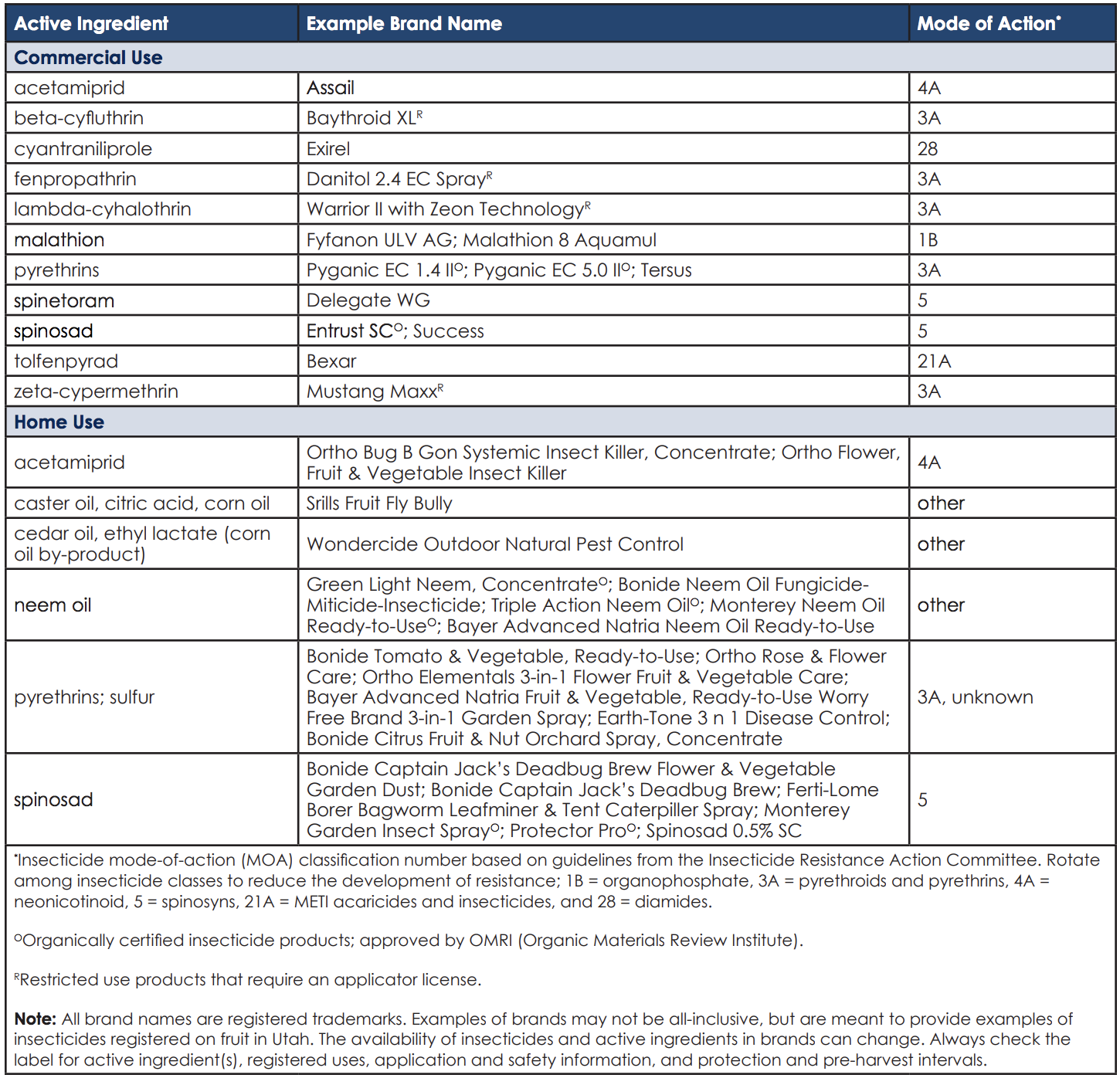
For Additional Information
- Invasive Fruit Pest Guide for Utah, USU Extension
- Monitoring for Spotted Wing Drosophila in Utah, USU Extension
- Spotted Wing Drosophila, Oregon State University
- MyPest Page Degree-Day/Phenology Models, Oregon State University
- Spotted Wing Drosophila in Home Fruit Plantings: Insecticide Options, Oregon State University
- Spotted Wing Drosophila, Washington State University
- Spotted Wing Drosophila, Michigan State University
Sources of Monitoring Supplies
AgBioWestminster, CO
303-469-9221
agbio-inc.com
Scentry
Billings, MT 800-735-5323
scentry.com
Great Lakes IPM
Vestaburg, MI
800-235-0285
greatlakesipm.com
Gemplers Mt.
Horeb, WI
800-382-8473
gemplers.com
Trécé
Salinas, CA
408-758-0205
trece.com
Alpha Scents
West Linn, OR
503-342-8611
alphascents.com



